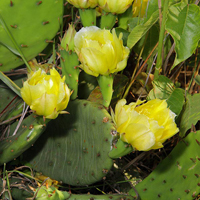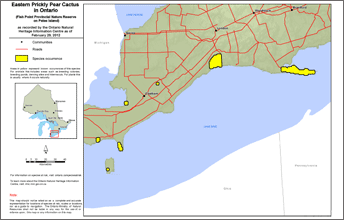Eastern Prickly-pear Cactus
Scientific name: Opuntia cespitosa

Cover photo credit: Allen Woodliffe
Status
Endangered
Endangered
means the species lives in the wild in Ontario but is facing imminent extinction or extirpation.
Date added to the Species at Risk in Ontario list
The Eastern Prickly-pear Cactus was already assessed as endangered when the Endangered Species Act took effect in 2008.
Read the assessment report
On January 26, 2022, the common and scientific names of this species were updated on the Species at Risk in Ontario List from Eastern Prickly-pear Cactus (Opuntia humifusa) to Eastern Prickly-pear Cactus (Opuntia cespitosa) to be consistent with recent taxonomic changes. This name change does not change the protections afforded to the species under the Endangered Species Act, 2007 or the applicability of any policies, permits and agreements, guidance documents – including recovery guidance – or best management practices that have been published or issued by the Government of Ontario in respect of the species.
What it looks like
The Eastern Prickly-pear Cactus is a perennial succulent cactus with jointed, rounded, but flattened, green stems, the segments of which are called “pads”. It may be horizontal or upright, growing up to 0.5 metres in height.
Typical of most cacti, the pads are armed with barbed bristles and spines. Yellow, waxy flowers about two to three centimetres in diameter, with centres, bloom along the edges of the pads. The juicy, edible fruits are green, ripening to reddish-brown.
Where it lives
The Eastern Prickly-pear Cactus grows in dry sandy areas that are relatively open and sunny.
It cannot grow in complete shade. It is found on sandy openings on dry, sometimes forested, hillsides and in sand dunes near beaches.
Where it’s been found in Ontario
In Canada, the Eastern Prickly-pear Cactus is found only in southern Ontario. There are two known locations, which are on sand spits along the shore of Lake Erie. Based on historical reports, this cactus may once have been marginally more widespread in areas near Lake Erie and Lake St. Clair.
View a Larger version of this map (PDF)
What threatens it
The main threat to Eastern Prickly-pear Cactus is habitat loss due to shoreline erosion and shading by trees and shrubs. It is also vulnerable to human interference from trampling, destruction of habitat and illegal collection for planting in gardens.
Invasive plants such as Spotted Knapweed (Centaurea stoebe) and White Sweet-clover (Melilotus alba) out-compete Eastern Prickly-pear Cactus in Ontario.
Action we are taking
Endangered Species and their general habitat are automatically protected
Recovery strategy
A recovery strategy advises the ministry on ways to ensure healthy numbers of the species return to Ontario.
Read the executive summary (January 11, 2013)
Read the recovery strategy (January 11, 2013)
Government response statement
A government response statement outlines the actions the government intends to take or support to help recover the species.
Read the government response statement (October 11, 2013)
Five-year review of progress
A five-year review of progress made toward protecting and recovering a species is required no later than five years after the government response statement for that species is published.
Read the report on progress towards the protection and recovery of 17 species at risk, including the Eastern Prickly-pear Cactus (2018).
Habitat protection
General Habitat Protection - June 30, 2008.
What you can do
Report a sighting
- The Ministry of Natural Resources and Forestry tracks species at risk such as the Eastern Prickly-pear Cactus. Report a sighting of an endangered animal or plant to the Natural Heritage Information Centre. Photographs with specific locations or mapping coordinates are always helpful.
Volunteer
- Volunteer with your local nature club or provincial park to participate in surveys or stewardship work focused on species at risk.
Be a good steward
- Private land owners have a very important role to play in species recovery. You may be eligible for stewardship programs that support the protection and recovery of species at risk and their habitats.
- Invasive species seriously threaten many of Ontario’s species at risk. To learn what you can do to help reduce the threat of invasive species, visit:
- The Canada-Ontario Farm Stewardship Program is available to farmers registered under the Canada-Ontario Environmental Farm Plan to encourage greater protection and conservation of habitat for species at risk.
Report illegal activity
- Report any illegal activity related to species at risk
1-866-MOE-TIPS (663-8477) .
Quick facts
- Ontario cacti rarely produce fruit and, instead, reproduce chiefly through pads breaking off parent plants and taking root nearby.
- Small mammals, especially rabbits, are the main dispersers of the sweet-smelling fruits and seeds.
- Birds sometimes nest among the stems of the Eastern Prickly-pear Cactus, where spines of the cactus aid in protecting eggs and nestlings from predators.
- Although very rare in Canada, the Eastern Prickly-pear Cactus is very common in the eastern United States where it is considered widespread, abundant and even weedy.
